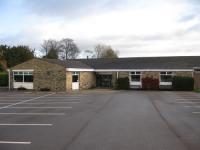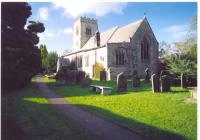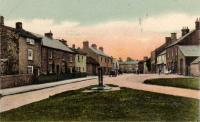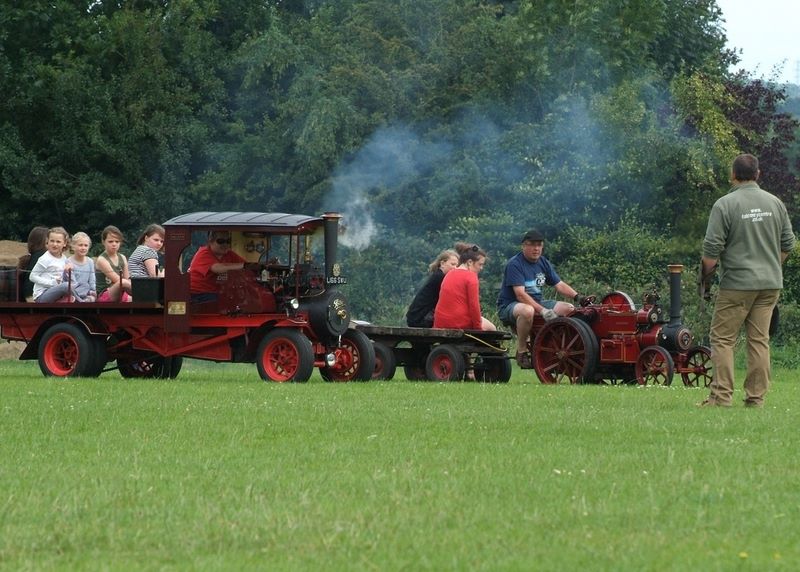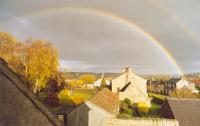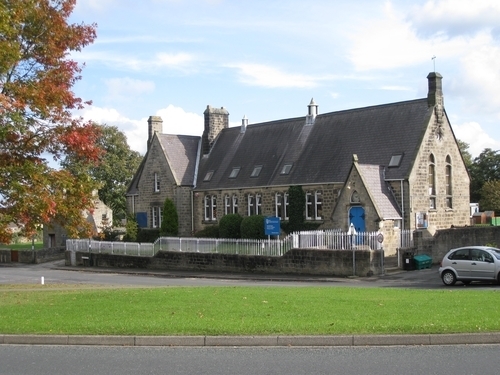Recent articles
© DT Online 2010 - 2025
| Hampsthwaite Methodist Church - by Mary GarsideIndex The Years from 1792 to 1904Our story starts long before the erection of the present church. Otley books record that Hampsthwaite members were holding class meetings in lofts and joiners’ shops as early as 1792. By 1800, with five members, they had become part of the Ripon Circuit and in 1818 the first church was built on land where now stand numbers 10 and 12 Hollins Lane. Seating 200, it was one of the oldest chapels in the circuit and had high-boxed pews which rose in tiers from front to back and a long flight of steps to the pulpit. Early in 1903 it was decided that this church should be replaced. It had no vestry, no provision for a schoolroom and would soon require a great sum of money for repairs. The decision was prompted by a legacy of £100 towards the enlargement of the church or the building of a new one, left by Mrs. Harkness, who had been associated with the old church for 50 years.
In May of that year permission was given by the Church Conference Assembly at Manchester to sell both the old church and land and to erect a new building on the adjoining plot. The stone laying ceremony was held in August 1903 and the church opening celebrations took place on March 25th 1904. (A transcript of the press report describing the opening ceremony is provided later). By the close of that day £666.10.4d had been raised towards the cost of the new church, which included £40 from the sale of the old one. The original estimate for the building was £800 but after additional items of furnishings, hymn books etc. the final cost was £1,135.2.4½d. The final payment of £45 was made in 1908.
Mrs Clough, who donated the land on which the existing chapel stands, bought the old chapel (plus the land behind the new one), and converted it into the two adjoining cottages, one of which is now called Diamond Cottage. The New ChapelThe architects were Messrs. Bland and Brown of North Park Road, Harrogate. The design is of perpendicular Gothic style and is built of local hammer scappled wall stones with dressing of the same stone outside and brick inside. The walls are 16ins. thick. The roof was clad with blue slates. The church was built to seat 106 people, exclusive of the choir. A schoolroom to the left of the church was linked by an ornamental traceried screen with moveable panels – this enabled the church to be extended when required. A porch was built with a small classroom to the left of it, later converted into a kitchen. To the right of the church a Minister’s Vestry with a small fireplace was built. A small stable was provided to accommodate the horse of visiting preachers who may have travelled some distance. The original heating was by open fires in the vestry and schoolroom and a central stove in the church. At a later date a coke-fired boiler was placed in the basement to heat large pipes in the church. The windows were fitted with leaded lights glazed with cathedral tinted glass with simple designs in the upper portions. Messrs. Barker Bros of Hampsthwaite were the masons and bricklayers. The charges for their work amounted to £334.12s and this including 10s.3d for excavating the basement. The joinery was done by Robert Settle of Summerbridge and also by Hebblethwaite and Bowers who used pitch pine for the pews. John and William Baynes of Harrogate did the roofing at a cost of £66. The two sets of gates and the iron railings were made by Octavius Atkinson (then in Tower Street, Harrogate) for the sum of £14.16s. There are two marble tablets in the church.  In April 1906, Mr. George Illingworth supplied a Sicilian marble tablet, lettered and fixed for the sum of £6. This records the details of the stone-laying ceremony.
 The second is a Memorial to Turner Grange. He was a Local Preacher for 73 years and died in 1911 at the great age of 96.
There is no record of a musical instrument in 1904 but in 1918, Mr. and Mrs. S. Lister presented a fine, hand-pumped organ in memory of their son, Sylvester.
In 1947, the church was registered for births, marriages and deaths. Also in that year, members must have been relieved when a water lavatory was installed behind the vestry.
By 1987 there was no longer the opportunity to purchase land behind the chapel for an extension and so a programme of renovations within the building was put in hand. The vestry was extended to incorporate the defunct stable and was named the 'Newsome Room' to mark the devoted work of Sister Annie Newsome in the chapel and in the village. The pews were removed and were replaced by linked, upholstered chairs. By the Autumn of 1989 the re-decorated church completed the renovations. Tragically, in early 1990 the church was gutted by fire and the roof badly damaged by smoke. Whilst the intense heat had twisted the organ pipes, the wooden cross on the wall alongside remained undamaged. (In 1959 a fire in the roof caused by an electrical fault was of minor intensity). Many people involved in the restoration of the church took part in the re-opening service on September 3rd 1990. This was only achieved by the diligent supervision of Mr Denis Dale, a retired architect.  Until now, special events in the church calendar had taken place in the Memorial Hall. Since the removal of the pews, all events have been held in the chapel itself. Harvest Suppers, Church Anniversary celebrations, visiting choirs, slide shows, concerts (plus refreshments) have all been possible. In 1992, a new kitchen was installed complete with a hatch to the schoolroom and this proved to be a great asset in holding the social events. To keep in line with current legislation, a further modification was made to the building in 2000 when an extra toilet was provided, specially adapted for use by the disabled. The chapel reached its Centenary in 2004 and, in contrast to its opening, the celebrations were designed to continue throughout the year. Exhibitions, attracting many visitors, were designed to show the life, times and vision of the chapel and its members within the village and surrounding area. The festivities were opened by Mr. Geoffrey Smith and a concert was presented by students from Henshaws College for the Blind. In the following weeks displays of photographic memories and a colourful flower festival entitled ‘100 years in Nidderdale’ were organised. The latter included, among the many splendid exhibits, a floral steam locomotive and carriages. The year continued with many meaningful services led by previous Ministers which gave rise to some nostalgia whilst looking forward to the future. A three course dinner, a family weekend with friends from Killinghall Chapel and a wonderful Harvest Festival brought closure to the Centenary celebrations. As part of the centenary project, several improvements were made to the chapel. In September 2006, outside ramps were installed to enable easy access for all. This entailed the removal of a single and a double gate. This was followed by the installation of outside lighting and in early 2007, new front and interior doors were provided. The ManseIn the 1920’s Deaconesses from the Training College at Ilkley would arrive in the village. They would park their caravan on the green and spend a week holding meetings and witnessing. Miss Louisa Harris, a member of the church, was so impressed by the work of the deaconesses that she bequeathed her house ‘Fernlea’ , opposite the church, for the use of a deaconess to minister in Hampsthwaite and district. Miss Annie Newsome was the first to be appointed and was installed in 1958. It was later used by ministers and their families. For this reason, Fernlea was sold in 1984 and a larger manse was purchased on Brookfield. The Sunday SchoolRecords show that there was already a Sunday School established when the new church opened in 1904. To help in fund-raising, 14 scholars were given a purse and encouraged to raise 5s each. This added £3.10s to the building fund. Three months after the church opened, a Sunday afternoon Flower Service was held where children would present posies of garden flowers. Janet Pritchard (nee Steel) recalled the custom in her childhood when, after the service, the flowers would be transported to Harrogate Hospital. It was in the 30’s that Mrs Winifred Lister and Mrs Hilda Lister revived the Sunday School. Children would gather in the chapel and then divide into classes using the vestry, school room and what is now the kitchen. The anniversary was a big occasion with every child taking part. They would be arranged around the large pulpit placed centrally at the front of the chapel. (In later years a small pulpit was built on the vestry side). Each child had a star card to record attendance. Children who never went away on holiday had a full card when prize giving was held in January. One of the highlights of the year was the Sunday School outing. At one time, held on Thursdays, it would alternate between the East coast and West coast. In 1952, 60 children and teachers plus parents went to Bridlington. They were joined by 40 children and helpers from Dr Barnardo’s Home at Hollins Hall. By 1966 there were 50 children on the register and 12 teachers. The suggestion of using the Memorial Hall was abandoned as it burnt down soon afterwards. Eventually the Manse was extended and some children used the extension to ease the congestion in the chapel. Surprisingly, until the 1960’s, the Methodist Sunday School was the only one in the village and was attended by children of Methodist and Anglican families. During this time, when Arnold Brown was Sunday School Superintendent, teachers included Millicent Bingley, George and Renee Pitt, Eileen Morris, David Lister and Susan Harris. Roger Bowers and several friends also held classes in the chapel on Sunday afternoon. All the children joined together at the start, divided into their various classes and then combined for the closing devotions. In 1993, children of the Sunday School planted acorns as part of the Harvest celebrations. Some became rooted and eventually Alan Chalk took charge of one. He brought it back from time to time to show the children how it was progressing. By the year 2000, under Alan’s expert care, the acorn shoot had become a healthy young oak tree. This was planted in the Millennium year at the junction of Rowden Lane and Grayston Plain and continues to flourish. In the 1960’s, Sunday leisure activities became acceptable and car ownership increased. For some years there had been a steady decline to the point where, since the summer of 2002, there has been no Sunday School at the chapel. Preachers, Ministers and People of the ChurchLocal Preachers play an important role in taking preaching appointments on Sunday in support of the clergy and in the early days there were many characters. Turner Grange had such a zeal to preach he often invited the visiting preacher to warm himself by the fire while he commenced the service. It could be some time before the appointed preacher was allowed to take his place in the pulpit. Early in his preaching career, Turner candidated for the Methodist ministry, travelling to Sheffield for his first interview. Sitting in an open carriage of a steam train, he arrived covered in soot. (He was not accepted for the ministry!) Richard Foster was a popular local preacher with a rich musical voice. A resident of Killinghall, he made his living delivering coal in the surrounding area. When his horse died, local Methodists subscribed to buy him a replacement to enable him to continue in business. Deaconesses have long been associated with the spiritual life of the chapel. Sister Annie Newsome, ably assisted by Sister Gladys Barran, was to prove an indefatigable worker both in the life of the church and in the village. Her Christian witness was extended into the heart of the community in which she lived. She held Bible classes and prayer meetings, opened an over-60’s Club and ran a Young Wives’ Group. Long after her official retirement she continued to keep a watchful eye on all church and village activities.
In the mid-thirties, Mr and Mrs T Lowis had settled in the district. They eventually became chapel caretakers and held various positions over a period of 30 years. At first, Mr. Lowis dealt with the acetylene lighting using carbide which was later replaced by gas. Each Saturday he would light the coke boiler in the basement. He would return at midnight to damp it down. If the coke was damp the chapel would be thick with smoke. However, he averred that it had always cleared by morning service on Sunday. One evening when thick snow lay on the ground he tripped over the hidden foot scraper and broke a bone. He still limped back later that night to tend to the boiler. 1945 saw the arrival of Rev Leslie Goy, described as “a dashing young man” who soon got involved with the young people of the chapel. He produced and took part in plays for the Youth Club, which were held in the Dale Hall as the first (wooden) Memorial Hall had not yet been constructed. At first, he travelled by bus to take Sunday Services, which were often timed to match the bus timetable. Eventually he acquired a cycle, but unfortunately skidded on ice one frosty morning and sustained a broken arm. Once again local Methodists came to the rescue and bought him a “jalopy”.Leslie and his wife Joan were welcomed with great affection when he returned to take services. There was already a choir when the present church was opened and the numbers fluctuated over the years. Mrs. Eva Houseman was organist for several years. At one stage her father, Mr. George Annakin, was the only member left in the choir. Nevertheless, he continued to take his place in the choir almost until his death. In 1947, it was decided to revive the choir and Mr. Scatchard became choirmaster. Mrs Houseman rehearsed the choir when, in 1952, the BBC’s overseas service came to make a live recording of the Harvest Festival Celebration. In 1954, Doris and John Giethoorn came to live in Hampsthwaite and two years later John became a trustee. Doris took over as organist in the 70’s and her sweet nature endeared her to all who met her. Assisted by Mrs. Johnson on the piano, she conducted a music group which performed at events throughout the church calendar. She also ran a choir for members of the Women’s Institute drawn from the district. For some years Doris coached children’s choirs at Killinghall and Hampsthwaite. In 1964, the church’s diamond jubilee was celebrated with a full weekend of events. Rev J Morgan was minister at that time assisted by Deaconess Audrey Stannard. The church membership was around 60 and there were 40 children in the Sunday school. In those days, officers served for long periods, their experience providing stability over the years. Some names to recall as stewards are Ted Parker, Ralph Robinson (also a choir member), Clifford Lister and Ernest Pinkney. Oswald Lister was treasurer (to be followed by his son Michael) and Ernest Atkinson was Sunday School Superintendent. One member of the Lister family who followed in her family’s footsteps is Mary Brown (née Lister). Mary became Flower Secretary in the early sixties and still carries this responsibility. The Rev Basil Jackson was appointed in 1967 and was the first minister, together with his wife Sandy, to live in ‘Fernlea’. His earlier service was as a missionary and latterly as principal of a Theological College in Sri Lanka, but he found no difficulty in adapting happily to a small village and chapel. We are left with the image of a humble and caring man who, despite poor health and failing eyesight, made a deep impression on all who knew him. With the touch of a saint and a vision of the ecumenical he strove to forge links between church and chapel. One of the loyal friends of the chapel was Mr. Bernard Wilson, by profession a sign writer. This warm-hearted gentleman provided large notices for the main celebrations in the church calendar over many years. At harvest time his colourful designs of fruit and vegetables were works of art and proclaimed to the village the bounty of the season. In 1974, Rev Henk Greenway became minister. Helped by his wife Renate, he gradually built up a strong group of young people drawn from the circuit and the Army Apprentice College. They would gather on Sundays for teatime fellowship at the Manse, join the evening service and then return to the Manse for Youth Club activities and discussions. They called themselves the Happy Hampers. In 1979, Henk was followed by Rev Shirley Ludlow. Throughout her ministry, Shirley was to prod and stimulate her flock with fresh ideas on activities and events in the church calendar. One of her brainwaves was to hold a Sunrise Service at Brimham Rocks on Easter Sunday. The occasion, the starkness of the rocks, the chill dawn and the sun rising cannot adequately describe the experience. One had to be there. Afterwards, we returned to the chapel for a full cooked breakfast cheerfully prepared by Mr. Bill Raper. The service has continued over the years (apart from 2001 when the outbreak of Foot and Mouth disease closed Brimham Rocks) and there is a warm welcome to all to join in this special experience.
Shirley Ludlow’s ministry in Hampsthwaite was cut short when she was transferred at short notice to another circuit. A young couple from the United States were appointed to minister for one year. Rev Joseph and Rev Christina Dowling-Soka married at short notice and arrived in the village with few possessions. They very soon endeared themselves to all who met them. Gentle and caring, they brought new experiences and led us along new paths in faith while they in turn soaked up our traditions and our lovely surroundings.
During the June of 1984, Christina’s parents came over from America to spend a month with her. Her father, the Rev Bob Soka, and her mother Grace shared in all our activities during their stay. The day before they left for home they were entertained to lunch where their host served Yorkshire pudding. On the flight home Bob wrote a poem about this new experience. A copy was sent to the Dalesman who published it the following May. Yorkshire Pudding’s not pudding at all, But very much YORKSHIRE like a dry-stone wall, Or flocks of sheep grazing hillside and dale Or walkers enjoying a foot-pathed trail. Yorkshire Pudding’s not pudding at all, But very much Yorkshire like Heptonstall, Or abbeys lying in marvellous ruin Or left-sided drivers who know what they’re doin’ Yorkshire Pudding’s not a pudding at all But much more Yorkshire than Hadrian’s wall. It’s like a 9.30 sunset at 4.00am dawn, Like a gorgeous garden with a golf-green lawn. Yorkshire Pudding is really a treat That reflects a people that are kind and sweet, With a wry sense of humour and hearts of gold Who’ll loan you their woollies in the mid-summer’s cold. So, here’s to a Pudding that brings to mind The most wonderful folks we’ll ever find – Steeped in Christ’s love that never ends, What a gladsome privilege to call you friends. The Dowling Sokas were followed by Rev Brian and Lyn Snellgrove, and their three young children. Brian and Lyn encouraged the church to make weekday activities available for children and young people in the village. Lyn, with John and Pauline Robson opened a weekly coffee bar. Young teenagers could enjoy an evening of relaxation, a game of pool, music and an opportunity to chat. Lyn also started a Mother and Toddler group, which met in the Newsome Room. The summer of 1996 found us yet again without our own minister. Rev Maurice Staton and Deacon Ian Cooper were appointed to share pastoral charge of Hampsthwaite, for one year only, in addition to their existing responsibilities. They both enjoyed the experience of meeting people in a village setting and those who took part in the Alpha Course led by Ian have happy memories of these meetings. In 1997, Rev Christopher Archer took over ministerial care of Hampsthwaite, Pannal and Killinghall. This was his first appointment after his training in Manchester. Christopher considered one of his most important roles in his ministry was his preaching. Erudite and well-read, his sermons never failed to stimulate and regularly presented a fresh approach to Biblical topics. In 2003, whilst there was no resident minister in Hampsthwaite, Rev Colin Emerson took over the pastoral care and oversight of our church, helping us to prepare for our centenary and the next one hundred years of Methodist mission and service in the village and surrounding area.
Since 2007, Rev. Christine Gillespie has guided us, overseeing in 2008 Hampsthwaite's Covenant between the parish church of St Thomas à Becket and the Methodist Church.
The Opening Ceremony of the Chapel in 1904The following is the transcript of the press report describing the opening ceremony of the new chapel on Friday 25th March 1904.
 Cup of celebration The Rev Colin Emerson with a commemorative centenary mug (0203043b). Picture: Steve Race
(A contemporary newspaper report)
return to index Methodist Ministers
Deacons and Deaconesses
return to index [The Land Valuation records prepared for the Inland Revenue in 1910 describe the chapel in the following terms . . . Hampsthwaite Methodist Church - by Mary Garside Index |
















